

"When I heard about what she did, I said, ‘How great that someone's doing what many of us should have done.'" "I have no opinion about that," another one said before quickly entering a mall. "I know nothing about it," said a woman with a small child on the bus, only to fix her eyes on the back of the seat afterwards and not glance in my direction again. So when I heard about the case of this woman - this Diana - who supposedly was trying to do something by herself, I wondered, after all these years without justice, if women in Juárez would look at Diana and say, "It's about time." So I went down there, to ask them.Īs you can imagine, most of the women I approached to get their opinions were reluctant to speak to a stranger about the woman who'd murdered bus drivers. "Then they played it down, and finally, they blamed the victims' lifestyle and their families." The criminologist resigned, he says, after realizing his superiors were more interested in covering up investigations and tampering with evidence than in finding justice. Oscar Maynez, who worked some of these cases as a criminologist, explained to me the way the authorities became complicit in the murders: "First they denied the problem," he said. Sometimes they were found together in mass graves. One day, a girl would disappear on the way to work or on the way home, and if there was any news about her, it would be when her body was found in the desert or an abandoned lot, often with traces of rape and torture. The circumstances of the crimes were eerily similar. In 2010, the number peaked: at least 304 women were murdered that year. So many women it was hard to count accurately. It went from dozens of reported murders in a year, to hundreds. After that, the number of women who were killed just kept growing. Or, at least, when people started recording these disappearances, and considering them as being related, after a 13-year-old girl was kidnapped and then found dead with signs of rape and strangulation. This year marks the twentieth anniversary of the first disappearances of young women in Juárez. The email was signed by someone calling herself "Diana, Hunter of Bus Drivers." And if we don't get respect, we will earn that respect with our own hands.

For we are seen as weak, but in reality we are not. That's why I am an instrument that will take revenge for many women.

#Cliff whitestone bus driver huntr drivers
We were victims of sexual violence from bus drivers working the maquila night shifts here in Juárez, and although a lot of people know about the things we've suffered, nobody defends us nor does anything to protect us. You think that because we are women we are weak, and that may be true but only up to a point, because even though we have nobody to defend us and we have to work long hours until late into the night to earn a living for our families we can no longer be silent in the face of these acts that enrage us. One day later, a news website from El Paso called La Polaka, which specializes in covering the political gossip of Juárez, received an email:

She walked towards the exit and motioned as if she were looking for the bus fare, but instead drew her gun, spat words into the driver's ear and shot him twice in the head - then fled the scene. A woman boarded the bus downtown and a few blocks later requested a stop. The second murder happened twenty-four hours later, on the same route. The killer, witnesses said, was a middle-aged woman with dyed blonde hair - or maybe it was a wig - wearing a cap, plaid shirt and jeans. The driver jumped out of the bus trying to escape but died on the sidewalk. That morning, a woman hailed bus 718, climbed the steps, pulled a gun and shot the driver. The first murder happened at 7:45 am, on August 28th, on bus route 4A.


 0 kommentar(er)
0 kommentar(er)
